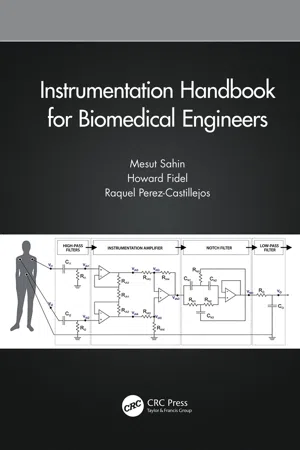
- 168 pages
- English
- ePUB (mobile friendly)
- Available on iOS & Android
Instrumentation Handbook for Biomedical Engineers
About This Book
The book fills a void as a textbook with hands-on laboratory exercises designed for biomedical engineering undergraduates in their senior year or the first year of graduate studies specializing in electrical aspects of bioinstrumentation. Each laboratory exercise concentrates on measuring a biophysical or biomedical entity, such as force, blood pressure, temperature, heart rate, respiratory rate, etc., and guides students though all the way from sensor level to data acquisition and analysis on the computer. The book distinguishes itself from others by providing electrical circuits and other measurement setups that have been tested by the authors while teaching undergraduate classes at their home institute over many years.
Key Features:
• Hands-on laboratory exercises on measurements of biophysical and biomedical variables
• Each laboratory exercise is complete by itself and they can be covered in any sequence desired by the instructor during the semester
• Electronic equipment and supplies required are typical for biomedical engineering departments
• Data collected by undergraduate students and data analysis results are provided as samples
• Additional information and references are included for preparing a report or further reading at the end of each chapter
Students using this book are expected to have basic knowledge of electrical circuits and troubleshooting. Practical information on circuit components, basic laboratory equipment, and circuit troubleshooting is also provided in the first chapter of the book.
Frequently asked questions
Information
Studio 1
Body Thermometer Using a Wheatstone Bridge and the Projection Method
S1.1 Learning Objectives
- 1.Learn the advantages of using a Wheatstone Bridge.
- 2.Become familiar with the projection method based on exponential function.
- 3.Understand the operation of a thermistor.
S1.2 Background


S1.3 Overview of the Experiment
S1.4 Safety Notes
S1.5 Equipment, Tools, Electronic Components and Software
- Equipment
- a. 9 V battery.
- b. Multi-meter.
- c. Data Acquisition Card (DAQ) installed into a computer.
- Tools
- a. Breadboard (protoboard).
- b. Two BNC-to-micro clips cables.
- Electronic Components
- a. Thermistor EPCOS (TDK) B57164K0103J000.
- b. Two 10K 1% resistors.
- c. 20 kΩ trimpot (10-turn is preferred).
- Software
- a. MATLAB®.
S1.6 Pre-Lab Questions
- 1. Do the students have knowledge of using trimpots and its terminal configuration? (e.g., the terminal that is physically in the middle is also shown in the middle in the schematic and the side ones are interchangeable).
- 2. Do the students know how to measure resistances using an ohmmeter and what the tolerance color codes of the resistors mean?
- 3. Do the students have an understanding of thermal resistance between the thermistor and the environment and how it affects the time constant of the...
Table of contents
- Cover
- Half-Title
- Title
- Copyright
- Contents
- Foreword
- Preface
- About the Authors
- Abbreviations
- Introduction
- Studio 1 Body Thermometer Using a Wheatstone Bridge and the Projection Method
- Studio 2 Electrophysiological Amplifier: Recording Electrocardiograms Through A Breadboard
- Studio 3 Small Signal Rectifier-Averager for EMG Signals
- Studio 4 Digital Voltmeter: Usage of Analog-to-Digital Converters
- Studio 5 Force Measurements with PZT Transducers
- Studio 6 Oscillometric Method for Measurement of Blood Pressure
- Studio 7 Electronic Stethoscope: Heart Sounds
- Studio 8 Transmission Photoplethysmograph: Fingertip Optical Heart Rate Monitor
- Studio 9 Measurement of Hand Tremor Forces with Strain-Gauge Force Transducer
- Studio 10 Optical Isolation of Physiological Amplifiers
- Studio 11 Extraction of Respiratory Rate from ECG (ECG-Derived Respiration-EDR)
- Studio 12 Heart Rate Variability Analysis in Frequency Domain
- Studio 13 AC Impedance of Electrode-Body Interface
- Appendix I: Using Electronic Components and Circuit Design
- Appendix II Required Equipment and Materials
- Index